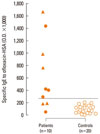1. Bertino J Jr, Fish D. The safety profile of the fluoroquinolones. Clin Ther. 2000. 22:798–817. discussion 797.
2. Suh YJ, Lee YM, Choi JH, Suh CH, Nahm DH, Park HS. Heterogeneity of IgE response to cefteram pivoxil was noted in 2 patients with cefteram-induced occupational asthma. J Allergy Clin Immunol. 2003. 112:209–210.
3. Kim JE, Kim SH, Jin HJ, Hwang EK, Kim JH, Ye YM, Park HS. IgE Sensitization to Cephalosporins in Health Care Workers. Allergy Asthma Immunol Res. 2012. 4:85–91.
4. Demoleas SE, Davies GF. Quinolones. Oral antibiotics of the future. J Am Podiatr Med Assoc. 1988. 78:522–525.
5. Dembry LM, Farrington JM, Andriole VT. Fluoroquinolone antibiotics: adverse effects and safety profiles. Infect Dis Clin Pract (Baltim Md). 1999. 8:421–428.
6. Aranda A, Mayorga C, Ariza A, Doña I, Rosado A, Blanca-Lopez N, Andreu I, Torres MJ. In vitro evaluation of IgE-mediated hypersensitivity reactions to quinolones. Allergy. 2011. 66:247–254.
7. Manfredi M, Severino M, Testi S, Macchia D, Ermini G, Pichler WJ, Campi P. Detection of specific IgE to quinolones. J Allergy Clin Immunol. 2004. 113:155–160.
8. Reaño M, Vives R, Rodríguez J, Daroca P, Canto G, Fernández J. Ciprofloxacin-induced vasculitis. Allergy. 1997. 52:599–600.
9. Dávila I, Diez ML, Quirce S, Fraj J, De La Hoz B, Lazaro M. Cross-reactivity between quinolones. Report of three cases. Allergy. 1993. 48:388–390.
10. Seitz CS, Bröcker EB, Trautmann A. Diagnostic testing in suspected fluoroquinolone hypersensitivity. Clin Exp Allergy. 2009. 39:1738–1745.
11. Schmid DA, Campi P, Pichler WJ. Hypersensitivity reactions to quinolones. Curr Pharm Des. 2006. 12:3313–3326.
12. González I, Lobera T, Blasco A, del Pozo MD. Immediate hypersensitivity to quinolones: moxifloxacin cross-reactivity. J Investig Allergol Clin Immunol. 2005. 15:146–149.
13. Lobera T, Audícana MT, Alarcón E, Longo N, Navarro B, Muñoz D. Allergy to quinolones: low cross-reactivity to levofloxacin. J Investig Allergol Clin Immunol. 2010. 20:607–611.






 PDF
PDF ePub
ePub Citation
Citation Print
Print



 XML Download
XML Download